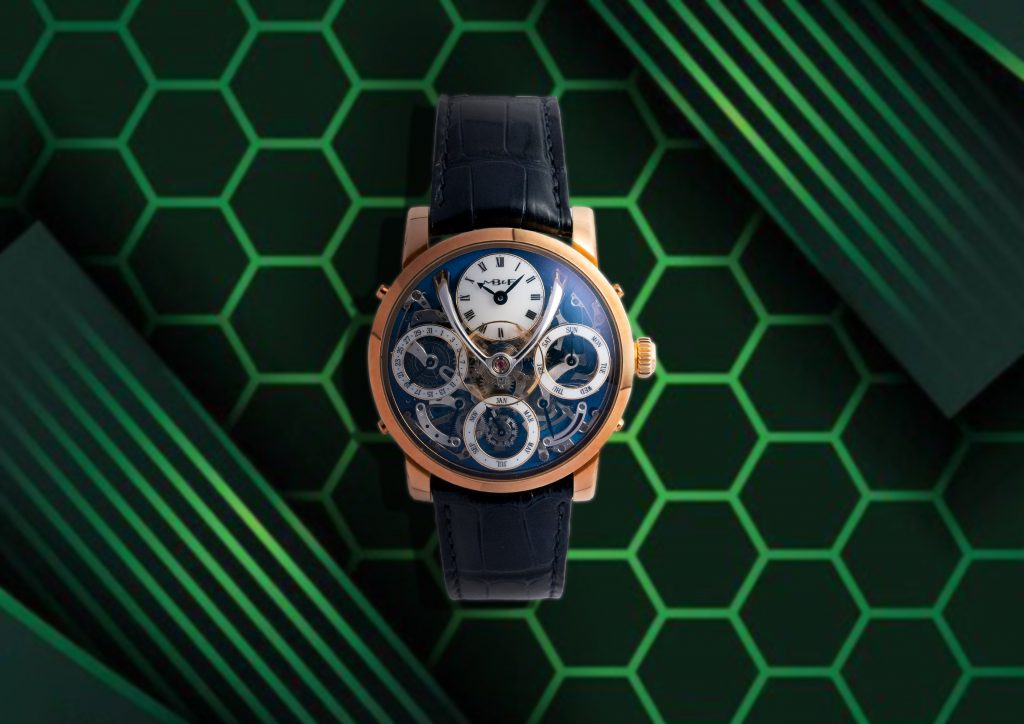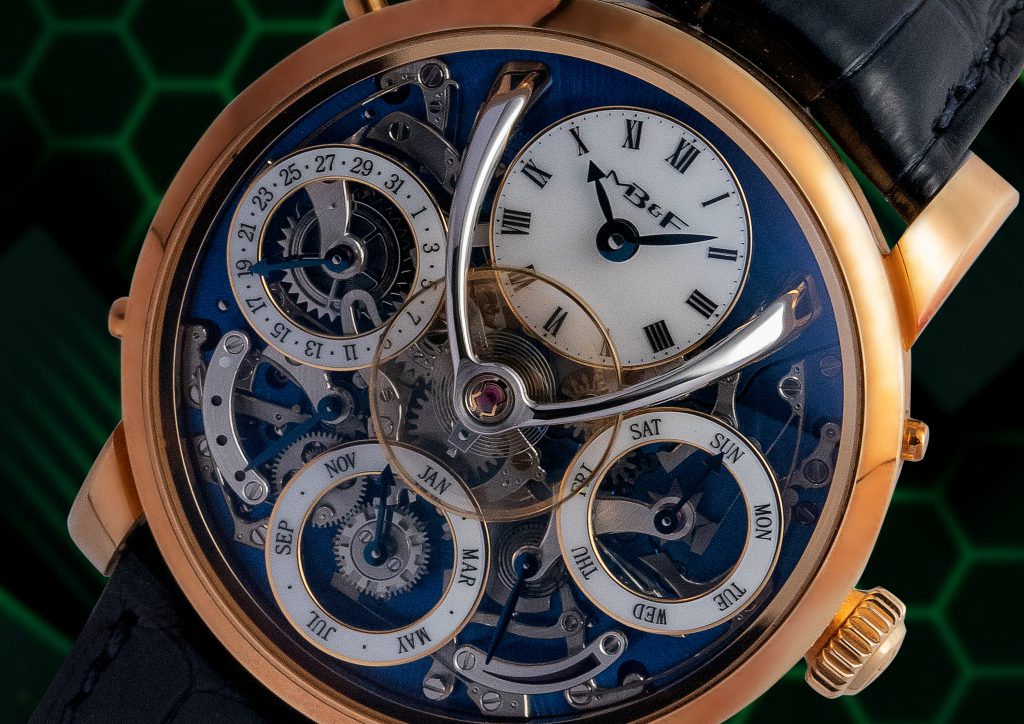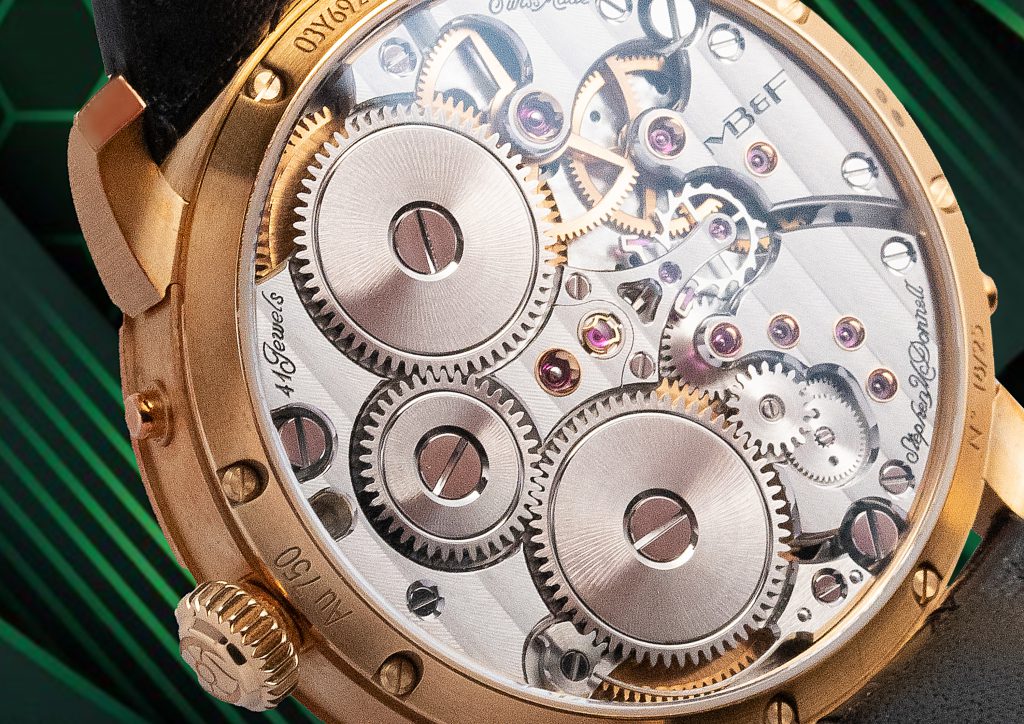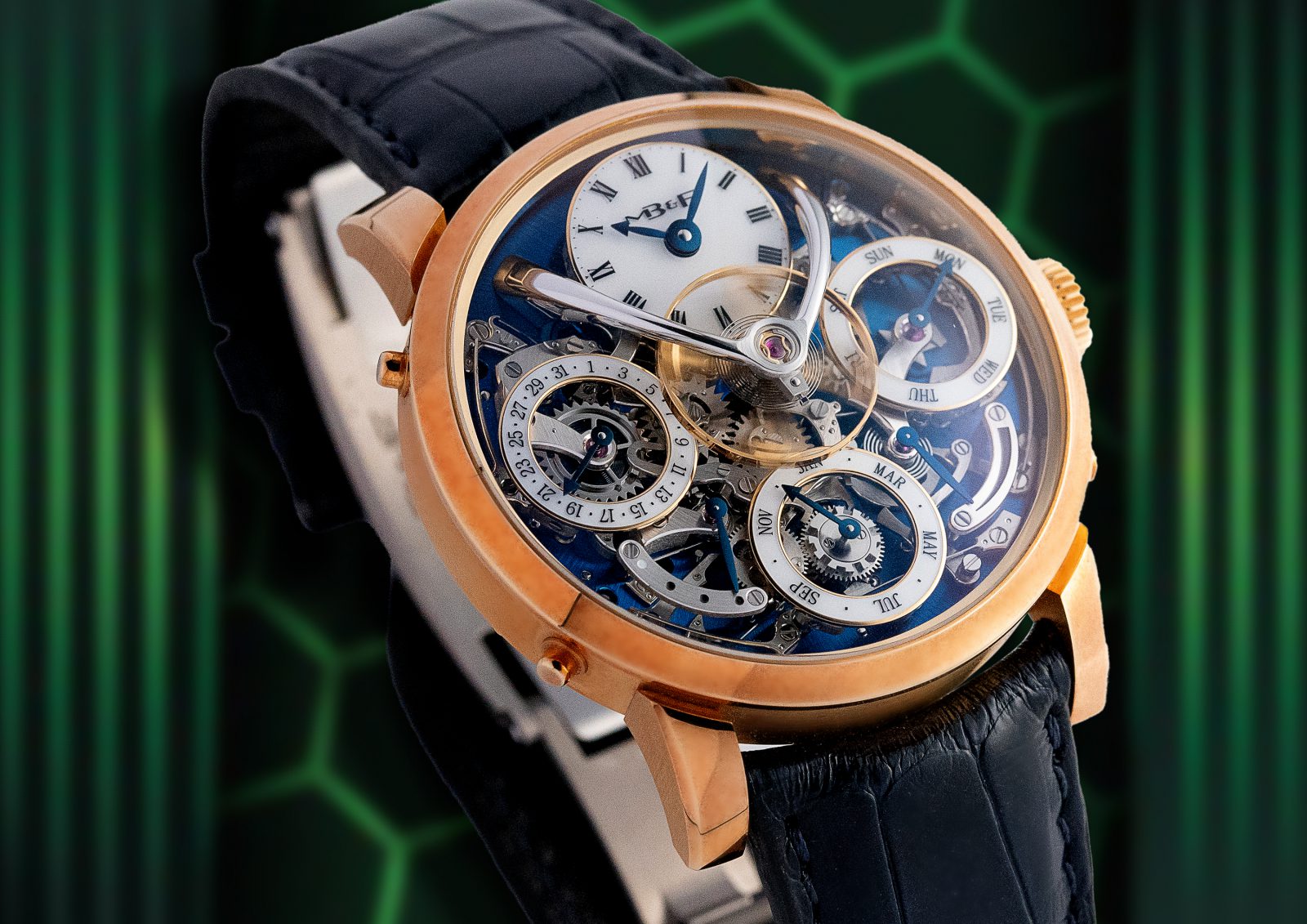When you own an MB & F, you own the creation from beautiful minds in the watch luxury. Maximilian Busser collaborates with friends (incredible figures in the watch industries) to create horological marvels that don’t look anything like “normal watches”. MB&F are a fresh and spirited group that built a name by teaming up with the world’s most talented watchmakers to make fantasy-type inventions. The results were wacky, novel and fun concepts that hit the mark for some but were a little too unconventional for others.

This astonishing Legacy Machine Perpetual developed with iconic watchmaker Stephen McDonnell in 2015 shook the entire watch industry. Reinventing the QP complication from scratch, with a default 28-day month and a mechanical processor, McDonnell’s novel technology eliminates the disadvantages and fragility of conventional perpetual calendars. This innovative creation impressed the jury of the GPHG to take home the Best Calendar Watch award of 2016. Since its birth, MB & F released the LM Perpetual in different metals, including rose gold, platinum, white gold, titanium and this spectacular 18k yellow gold model is limited to 25 pieces we have with us today.
Prior to the LM3, MB&F’s use of complications was limited to the tourbillon and executed mainly for an aesthetic impact. This LM3 Perpetual Calendar marked the first time MB&F took on a traditional high-complication and executed it in their signature, forward-thinking style; making it a horological milestone in a space where only a handful of perpetual calendar variations had existed.
Master of Contemporary and Innovation – LM Genesis
Within the LM collection ,the Legacy Machine 1 first debut in 2011 came as something of a shock to seasoned MB&F fans. The birth of the first Legacy Machine in 2011 was considered the quiet sibling in MB&F’s universe of intergalactic spacecraft with astonishing cases and complex displays.
HMs are like Lamborghini, aggressive, flamboyant and Avant-garde.
LMs are like Ferrari, elegant, sophisticated and classic.
MB&F’s Legacy Machine 1 was round with classical features like the white lacquered sub-dials with Roman numerals. The Legacy Machine was Max Büsser’s tribute to some of the great horological innovations and Grand Master watchmakers of the 19th century with a distinctive MB&F twist.
Inspired by the engineering miracles of Gustave Eiffel, the fantastical worlds of Jules Verne and the mechanics and aesthetics of the 19th-century pockets watches, the Legacy Machine revealed the hand of its master with its dramatic staging of the flying balance wheel on the dial held in place by a spectacular V-shaped arching bridge. Since 2011, the Legacy Machine has appeared in countless guises and spawned eight unique calibres scaling colossal horological heights with the LM Perpetual and the spectacular LM Thunderdome with its triple-axis regulator.
The Legacy Machine responded to Maximilian Büsser’s vision of producing a watch that he could have created had he been born in 1867. With its steampunk personality that Jules Verne would have warmed to, the salient features of the LM were the large balance wheel placed smack in the centre of the dial and the pronounced domed sapphire crystal over the dial.
A Masterfully Executed Revamp – LM Perpetual Calendar

Four years later, in 2015, the Legacy Machine Perpetual LM3 was unveiled, the brand’s first perpetual calendar complication made in collaboration with Stephen McDonnell. An independent watchmaker from Northern Ireland, McDonnell had been mulling with an idea to redesign the complication and eliminate many of the drawbacks associated with the 150-year-old technology still used today on conventional QPs.
The calendar indications of most perpetual calendars are synchronised by a grand levier, which in turn requires a great deal of space to perform its backwards and forwards motions. This traditional system also assumes that months have 31 days. To adjust for months with fewer days, the long lever skips over superfluous dates to reach the first day of the new month. However, any manipulation or adjustment of the date during this changeover period can damage the mechanism.
McDonnell’s dream was to create a less fragile mechanism that would allow the correctors to be pressed at any time of day. McDonnell explained that users will always be obliged to move through 31 days with conventional systems, even if 31 days is not needed. He wanted to create a mechanism that will jump precisely from the last day of the month to the first with no hesitation. The solution was a mechanical processor composed of a series of superimposed discs on a planetary cam. Taking the default number of days in the month at 28 and adding the extra days as required, McDonnell’s invention meant there was no skipping over redundant days and no chance of the date jumping incorrectly.
Inner and Outer Beauty, through and through

In many ways, MB&F reinvented the idea of the perpetual calendar, building on ideas seen in earlier examples of the Legacy Machine series. Just as the balance is raised above the dial in the LM 1, the idea was to elevate the perpetual calendar displays above the main plate. This required re-construction of the movement, as the posts used to support the dials stopped a traditional lever system from operating. MB&F and Stephen McDonnell replaced the complex and delicate lever system, and opted instead for a series of stacked gears. This neat approach not only enabled the free-spirited design of an open-worked dial, but had the added benefit of displaying the functions clearly and legibly on the dial side.
The 18k yellow gold case measures 44mm with a height of 17.5mm and features refined contrasting brushed and polished finishes. The spectacular domed sapphire crystal reveals the fascinating architecture of the movement on the dial rising from the dark blue base and supported by pillars.

The brand’s signature 14mm “flying” balance is seen at the centre of the dial, utilising a split escapement that operates on both sides of the movement, via a large central stem. The flying balance is surrounded by four suspended dials to relay the information of the perpetual calendar mechanism and the time. The dials corresponding to the date, day and month are hollowed out in the centre to reveal more elements of the 581-part movement and all the hands are blued. In addition to the beautiful 3-dimensional architecture of the dial, the beauty of this movement is that all the functions – hours, minutes, day, date, month and retrograde leap year – can be adjusted independently by pressing the correctors on the case band.
The reverse side of the case reveals other parts of Stephen McDonnell’s fully integrated, manual-winding perpetual calendar movement with its mechanical processor and inbuilt safety mechanism. The escapement is clearly visible as are the double barrels providing the movement with 72 hours of autonomy. In keeping with its 19th-century spirit, the hand-finishes are superlative with internal bevelled and polished angles, large gold chatons, Geneva waves on the bridges and hand-engraved surfaces.
Further to this, the calibre introduced a default length of 28-day months, as opposed to the traditional use of 31 days. With this, a “jump” of up to four days can be avoided at the end of certain months, making date switches more reliable, and ensuring each month would switch at the correct number of days. The calibre also makes use of an internal safety system, deactivating the correctors at date changeovers, to spare the movement from accidental damage by its user.
Manufacturer
MB&F
Caliber Number
LM-Perpetual
Type
Manual wind
Jewels
41
Number of Parts
581
Power Reserve
72 hours
Vibrations Per Hour
18,000 bph (2.5Hz)
Functions
Hours and minutes at 12:00, day of the week at 3:00, date at 9:00, month at 6:00, retrograde leap year between 7:00 and 8:00, power reserve indicator between 4:00 and 5:00
Features
Manual winding with double mainspring barrels. Bespoke 14mm balance wheel with traditional regulating screws visible on top of the movement. Superlative hand finishing throughout respecting 19th-century style; internal bevel angles highlighting hand craft; polished bevels; Geneva waves; hand-made engravings.
Final Thoughts

The goal of the Legacy Machine series was to create a tribute to fine and antique watchmaking of the past, and combine it with the forward-facing, creative finesse of MB&F. In its aesthetics, the nod to the past is largely achieved through the classical, round shape of the case, sized at 44.5mm. Everything about the LM3 highlights the superlative hand-finishing of traditional, 19th-century watchmaking.
The MB&F’s progressive, avant-garde style is most apparent in the open-worked dial, and in the floating effect of the raised discs. Pristine white, stretched-lacquer sub-dials are found at 3, 6, 9 and 12 o’clock; displaying the day, month, date and time, respectively. The hands are made from blued-gold, whilst the grey main plate is decorated with a sun-ray pattern.
The high-domed sapphire crystal that has been coated with an anti-reflective material further emphasised the unique architecture of the Legacy Machine 3 Perpetual.
This LM3 is definitely one of my personal favourite MB&F and McDonnell’s argument is logical and it certainly looks the part. I especially loved that huge central flying balance.
Based on historical price data from auction houses and transacted sales history in the secondary market, the projected growth per annum for the MB&F LM3 Perpetual Calendar is estimated to be around 6%. In 2021, we’ve witnessed an increase in demand for independent watchmakers as collectors’ attention are starting to shift to brands like FP Journe, MB & F, De Bethune and H.Moser. With a limited supply and production of watches every year, we expect that MB&F will have exponential growth in value over the next few years.

